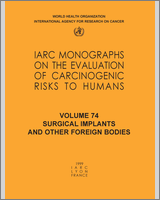NCBI Bookshelf. A service of the National Library of Medicine, National Institutes of Health.
IARC Working Group on the Evaluation of Carcinogenic Risks to Humans. Surgical Implants and Other Foreign Bodies. Lyon (FR): International Agency for Research on Cancer; 1999. (IARC Monographs on the Evaluation of Carcinogenic Risks to Humans, No. 74.)
The exposure of interest in this monograph is the presence within the body of a solid metallic or non-metallic object as a result either of surgery or of involuntary penetration (as, for example, through a war wound).
Excluded from evaluation are exposures to:
- occupational handling of materials designed for implantation
- radiation emitted by any implanted object
- any device designed to lie on the surface of the body, either on the skin or within a cavity lined by endothelium (for, example, contact lenses and intra-uterine contraceptive devices)
- intra-ocular implants
- cochlear implants
- certain materials, including suture materials derived from animal tissues, foreign bodies of vegetable origin, and glasses
- allografts and xenografts of bone or other connective tissue
In this general introduction, some key concepts in our current understanding of host–material interactions are presented. These include consideration of the degradation of materials within the body, general mechanisms of chemical and solid state carcinogenesis, and a discussion of the pathology of sarcomas. This is followed by a short description of some characteristics of epidemiology as they relate to the study of cancers associated with implanted devices.
Subsequent chapters describe human exposure data, evidence from case reports and analytical studies for carcinogenicity in humans and in companion animals, evidence of carcinogenicity of implanted materials from animal experiments, and further background material on mechanisms of degradation and carcinogenicity. Finally, a summary of evidence and an overall evaluation of current evidence are provided.
Some of the substances that constitute, or may be released from, foreign bodies have been evaluated previously within the IARC Monographs. These are listed in Table 1.
Table 1
Substances found in (or potentially originating from) foreign bodies that have been evaluated for carcinogenicity previously in the IARC Monographs programme.
Elsewhere in this introduction, statements regarding the carcinogenicity of other specific chemicals and materials should not be construed as evaluations by this Working Group and are included only to illustrate mechanistic concepts.
The approach adopted in this volume is to consider sequentially metallic, nonmetallic and mixed materials, which have different profiles of biological activity. This introduction brings together a number of diverse, multidisciplinary issues that are important in evaluating the carcinogenic risks associated with implanted biomaterials and other foreign bodies. These issues are:
- Host–biomaterial interactions
- General mechanisms of solid-state carcinogenesis
- Pathology of sarcomas, reactive and pseudoneoplastic conditions
- General issues in human epidemiological research on implants and cancer
- Scope of the monograph - Surgical Implants and Other Foreign BodiesScope of the monograph - Surgical Implants and Other Foreign Bodies
- Homo sapiens E2F transcription factor 6 (E2F6), transcript variant a, mRNAHomo sapiens E2F transcription factor 6 (E2F6), transcript variant a, mRNAgi|1519312678|ref|NM_198256.4|Nucleotide
Your browsing activity is empty.
Activity recording is turned off.
See more...
